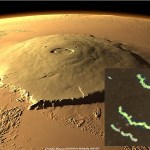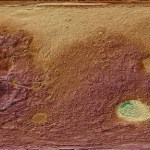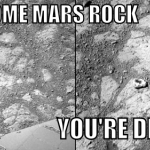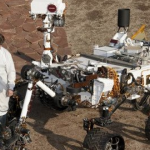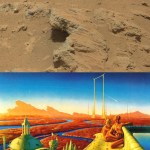Mars
Photo of Astronaut Robert Overmyer from NASA, via Wikimedia Commons.
I recently went on a trip to visit the Endeavour space shuttle currently on display in Los Angeles. Seeing the shuttle up close brought back memories of watching the space shuttle launches on TV and the childhood dream of visiting other planets...a dream that also inspires Hollywood to continue to produce movies and TV shows about space exploration. Turns out, The Martian movie may soon become reality. In fact, NASA is working towards sending astronauts to Mars sometime in the 2030's. Aside…
On Life Lines, Dr. Dolittle examines the fascinating parallels between hummingbird and insect flight. He and/or she writes: "The researchers placed nontoxic paint on the wing of a ruby-throated hummingbird at 9 different spots then videotaped the animal flying at 1,000 frames per second with 4 cameras simultaneously." Despite being far removed from insects on the phylogenetic tree, hummingbirds "stir up air around their wings in a way similar to insects like mosquitoes and dragonflies." This is an example of convergent evolution, as natural selection engineers similar solutions for very…
Speaking of sulfur: This common element turns out to be highly useful for understanding planetary processes – both on Earth and Mars. Two new papers by Dr. Itay Halevy use sulfur chemistry to understand the history of sulfur-loving microbes at the bottom of the ocean and the compounds spewed from Martian volcanoes that may have created brief Martian “springs.”
Sources of sulfur: Olympus Mons on Mars and sulfate-reducing bacteria that live in water on Earth (inset)
On the ocean beds, microorganisms “breathe” sulfur: They take in sulfate – an abundant compound of oxidized sulfur, and use it…
Ethan Siegel calls Mars "the obvious first step in our journey to the stars" and "part of our dreams for reaching out into the Universe." Last year thousands of people applied to join Mars One, a proposed colonization effort slash reality show that plans to put humans on the red planet in 2023. But unless Mars One wants to achieve ratings by broadcasting the death of its crew, it may want to cool its jets. Ethan says that without some heretofore unknown, top secret-technology, there's no hope for safely landing a capsule-full of "sensitive meatbags" (aka bachelors 1 through 3) on the surface…
Look at the rock on the right, and the lack of rock on the left. (Our left.) It is being reported that this jelly-donut size rock appeared out of nowhere on the Martian surface between photographs.
There are several possible explanations for this.
1) It grew there.
2) It was ejected from a steam vent or something and flew there.
3) This is what a Martian looks like. It will eventually move on.
4) The robot that took the first picture tossed the rock up while driving by.
5) It is a jelly donut.
6) The rock was placed there to cover up a footprint.
What do you think?
I love it when stuff…
Over the next 10 years, what research done on bodies within our Solar System (measurements and theory) will be most important for informing our search for life beyond the Earth?
This is the current topic posed as the Single Question on the Future of Astrobiology at the ongoing NASA Astrobiology Institute Roadmap online exercise.
If you want to opine, The Forum is Open
You certainly didn't hear it here first: today NASA, at a press briefing, announced that minerals analyzed by the Curiosity rover indicate that life might, in the galactic past, have survived on Mars. The rover's been poking around an ancient network of stream channels descending from the rim of Gale crater since September of last year; now, after drilling into the sedimentary bedrock nearby, it's hit on a treasure trove of life-supporting minerals: carbon, oxygen, hydrogen, phosphorus, sulfur, and nitrogen. These mineral findings are really just icing on the cake, as the geological…
The wonderful Curiosity rover on Mars has been much in the news lately, but let's not forget about the previous rover generation! Opportunity landed on Mars nine Earth calendar years ago today on 25 January, and it still works fine. Its mate Spirit was mobile on the Red Planet for over five years and then functioned as a stationary science platform for another year before getting killed off by a Martian winter it couldn’t avoid. Amazing engineering that keeps working year after year without a technician so much as touching it.
Oppy is still on the rim of Endeavour crater, the area where it's…
Despite rumors to the contrary, NASA actually does real, non-Parody science! And the famous press conference about Mars Rover happened today, and it was exactly as I predicted. Very, very interesting.
PASADENA, Calif. - NASA's Mars Curiosity rover has used its full array of instruments to analyze Martian soil for the first time, and found a complex chemistry within the Martian soil. Water and sulfur and chlorine-containing substances, among other ingredients, showed up in samples Curiosity's arm delivered to an analytical laboratory inside the rover.
Detection of the substances during this…
As you know, NASA is planning a press conference later today, but you don’t have to wait for the big news. It was leaked, and I’ve got it.
The NASA Curiosity Mars Rover has discovered something interesting and rather enigmatic. I understand NASA will be asking your help in trying to identify what it is.
At first, the object appeared as three enigmatic shapes, kind of gray in color, very near each other, spotted in a ground-oriented medium resolution image. This is what the Rover image looked like:
Spectral analysis of the objects indicated that they are similar to igneous rock, but with a…
I'm kidding, I'm kidding, NASA did not say that. But I do think people need to take it down a notch with this whole blaming NASA for doing their press conferences wrong. As far as I know, the Curiosity Martian Laboratory Robot recently approached a non nondescript pile of dirt, analyzed the bejesus out of it as a test of the fancy dancy instruments on board, and everything worked. The pile of dirt was not interesting but they did to that pile of dirt what would have required 3,000 feet of laboratory floor space full of expensive equipment and a dozen technicians working for two months back…
Quite possibly. Here's a picture of it:
Image from NASA. Obviously.
There's a pretty good chance that this is a manufactured object and not some natural thingie that formed on the surface of Mars by Mars-esque natural processes. But, if that's true, then there's a pretty good chance that the object, formed by an intelligent being, is just some piece of junk that fell off of one of the alien space ships that has landed on Mars recently. Alien to Mars, sent by Earthlings.
It reminds me of this one time... we were doing survey in a certain region which shall remain nameless, and finding lots…
Do ghosts really exist?
Is there life on Mars?
Despite what one might think, what with large class sizes and the homogenization of culture caused by TV and Fast Food, the fact remains that clumps of high school students organized into classes can vary widely from one another. Each year has its own characteristics, and each classroom-sized bunch of them, taking a particular course together, can be very different from the next. A teacher I know has ended up this year with a science class with a large proportion of students who believe that ghosts are real, and while they are at it, they also…
The space-heads among you have undoubtedly heard about the Curiosity rover's first significant discovery: the remnants of an ancient streambed on Mars, which would seem to indicate the presence of water in the planet's history. This jagged pile of alluvial rock and dust may not look like much, but it brings to mind one of my favorite pieces of Martian historical arcana.
For a time in the late 19th century, it was believed that there were canals on Mars.
The Italian astronomer Giovanni Schiaparelli, who observed Mars in 1877, was the first to describe, name, and lovingly illustrate…
The "Next Media" animation company used to send me several animations a week (a few a day for a while) but then they were bought out by a major media outlet (can't remember which one) so most of the emails I get from them now are about how great they are, rather than providing much current content. But today I got a not-very-current animation that seems pretty good and I thought you might like it, of the Mars Curiosity landing and field research:
Today, NASA did something never before done, and well, not all that impressive.
Charles Bolden of NASA spoke some words into a microscope, and this voice stream was sent to the Curiosity Rover on Mars, which then sent it back. Hey, I just spent the last 15 minutes swapping monitors around on my computers, and those monitors had cables that had been secured with cable ties and that ran through conduits and stuff. I’m thinking what I did was harder.
According to NASA, Bolden said:
The knowledge we hope to gain from our observation and analysis of Gale Crater will tell us much about the…
Here's the last few news reports:
August 21:
NASA's Curiosity Studies Mars Surroundings, Nears Drive
NASA's Mars rover Curiosity has been investigating the Martian weather around it and the soil beneath it, as its controllers prepare for the car-size vehicle's first drive on Mars.
The rover's weather station, provided by Spain, checks air temperature, ground temperature, air pressure, wind and other variables every hour at the landing site in Gale Crater. On a typical Martian day, or "sol," based on measurements so far in the two-week old mission, air temperatures swing from 28 degrees to…
Never mind the heat shield, the parachute, the thruster-guided landing, all of that. Curiosity went to Mars to carry out experiments using Big Science Gear and now it is confirmed that at least one set of gear works!
The method is laser-induced breakdown spectroscopy, in which very high power but short burst laser light is focused on a thing, and the matter the thing is made up of is drastically altered in such a way that it gives of a signal that can be picked up by instruments also pointed at the thing, to produce a spectrosopic signature.
There is no useful analysis of the data yet,…
The Angry Red Planet just gut a little angrier:
This sequence of images shows the heat shield from NASA's Mars Science Laboratory hitting the ground on Mars and raising a cloud of dust.
From NASA
A whole bunch of photographs rom Mars have bee posted by NASA, here. I thought the following one was pretty cool because it shows how accommodating the Martians are, cleaning the dust off the lens and all.
This image comparison shows a view through a Hazard-Avoidance camera on NASA's Curiosity rover before and after the clear dust cover was removed. Both images were taken by a camera at the front of the rover. Mount Sharp, the mission's ultimate destination, looms ahead. The view on the left, with the dust cover on, is one quarter of full resolution, while the view on the right is full…

